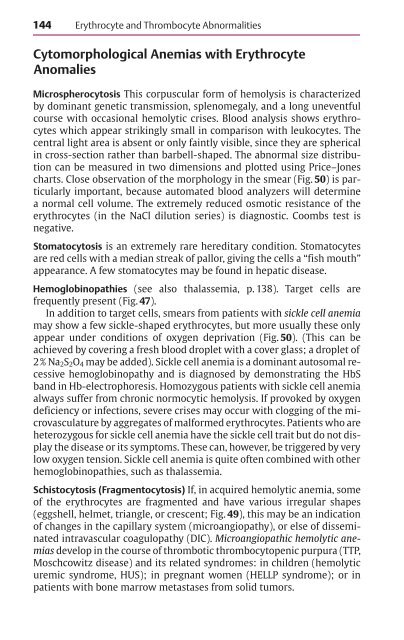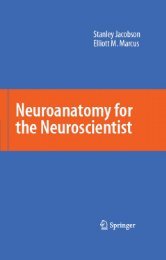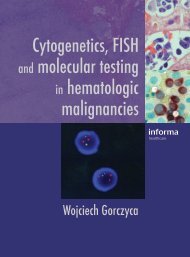Color Atlas of Hematology - Practical Microscopic and Clinical ...
Color Atlas of Hematology - Practical Microscopic and Clinical ...
Color Atlas of Hematology - Practical Microscopic and Clinical ...
- No tags were found...
You also want an ePaper? Increase the reach of your titles
YUMPU automatically turns print PDFs into web optimized ePapers that Google loves.
144 Erythrocyte <strong>and</strong> Thrombocyte AbnormalitiesCytomorphological Anemias with ErythrocyteAnomaliesMicrospherocytosis This corpuscular form <strong>of</strong> hemolysis is characterizedby dominant genetic transmission, splenomegaly, <strong>and</strong> a long uneventfulcourse with occasional hemolytic crises. Blood analysis shows erythrocyteswhich appear strikingly small in comparison with leukocytes. Thecentral light area is absent or only faintly visible, since they are sphericalin cross-section rather than barbell-shaped. The abnormal size distributioncan be measured in two dimensions <strong>and</strong> plotted using Price–Jonescharts. Close observation <strong>of</strong> the morphology in the smear (Fig. 50) is particularlyimportant, because automated blood analyzers will determinea normal cell volume. The extremely reduced osmotic resistance <strong>of</strong> theerythrocytes (in the NaCl dilution series) is diagnostic. Coombs test isnegative.Stomatocytosis is an extremely rare hereditary condition. Stomatocytesare red cells with a median streak <strong>of</strong> pallor, giving the cells a “fish mouth”appearance. A few stomatocytes may be found in hepatic disease.Hemoglobinopathies (see also thalassemia, p. 138). Target cells arefrequently present (Fig. 47).In addition to target cells, smears from patients with sickle cell anemiamay show a few sickle-shaped erythrocytes, but more usually these onlyappear under conditions <strong>of</strong> oxygen deprivation (Fig. 50). (This can beachieved by covering a fresh blood droplet with a cover glass; a droplet <strong>of</strong>2% Na 2 S 2 O 4 may be added). Sickle cell anemia is a dominant autosomal recessivehemoglobinopathy <strong>and</strong> is diagnosed by demonstrating the HbSb<strong>and</strong> in Hb-electrophoresis. Homozygous patients with sickle cell anemiaalways suffer from chronic normocytic hemolysis. If provoked by oxygendeficiency or infections, severe crises may occur with clogging <strong>of</strong> the microvasculatureby aggregates <strong>of</strong> malformed erythrocytes. Patients who areheterozygous for sickle cell anemia have the sickle cell trait but do not displaythe disease or its symptoms. These can, however, be triggered by verylow oxygen tension. Sickle cell anemia is quite <strong>of</strong>ten combined with otherhemoglobinopathies, such as thalassemia.Schistocytosis (Fragmentocytosis) If, in acquired hemolytic anemia, some<strong>of</strong> the erythrocytes are fragmented <strong>and</strong> have various irregular shapes(eggshell, helmet, triangle, or crescent; Fig. 49), this may be an indication<strong>of</strong> changes in the capillary system (microangiopathy), or else <strong>of</strong> disseminatedintravascular coagulopathy (DIC). Microangiopathic hemolytic anemiasdevelop in the course <strong>of</strong> thrombotic thrombocytopenic purpura (TTP,Moschcowitz disease) <strong>and</strong> its related syndromes: in children (hemolyticuremic syndrome, HUS); in pregnant women (HELLP syndrome); or inpatients with bone marrow metastases from solid tumors.






